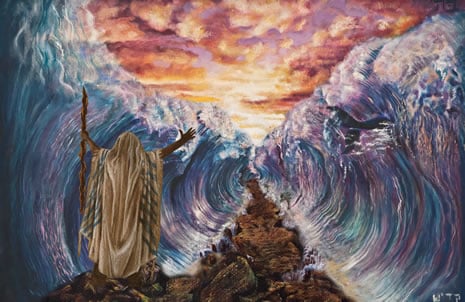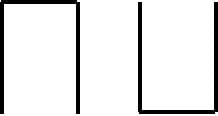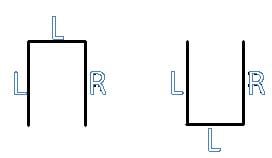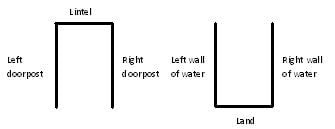Do you like riddles? Here is a riddle – what do these two figures represent in the context of Exodus?
No Idea? How about a hint?
Still no idea? Okay, here is the answer:
Yes, the first figure represents two doorposts and the lintel marked with the blood of Passover sacrifice, as it says:
וְלָקְחוּ, מִן-הַדָּם, וְנָתְנוּ עַל-שְׁתֵּי הַמְּזוּזֹת, וְעַל-הַמַּשְׁקוֹף–עַל, הַבָּתִּים, אֲשֶׁר-יֹאכְלוּ אֹתוֹ, בָּהֶם
And they shall take of the blood, and put it on the two side-posts and on the lintel, upon the houses wherein they shall eat it. (Ex. 12:7)
The second picture is of the splitting of the sea, as it says:
וַיָּבֹאוּ בְנֵי-יִשְׂרָאֵל בְּתוֹךְ הַיָּם, בַּיַּבָּשָׁה; וְהַמַּיִם לָהֶם חוֹמָה, מִימִינָם וּמִשְּׂמֹאלָם
And the children of Israel went into the midst of the sea upon the dry ground; and the waters were a wall unto them on their right hand, and on their left. (Ex. 14:22)
Granted, both pictures look similar. But is there any significance to this similarity? Standing on the shore of the Sea of Reeds the Jewish people were standing at a threshold. Behind them – in their past – was Egypt. In front of them – in their future – was Sinaitic theophany – Giving of the Torah at Mount Sinai. The sea was the doorway through which they were to enter into their future. Just as the root of the word “mezuzah” is zuz – “to move,” G‑d commands the Jewish people standing at the shore to keep on moving:
וַיֹּאמֶר יְהוָה אֶל-מֹשֶׁה, מַה-תִּצְעַק אֵלָי; דַּבֵּר אֶל-בְּנֵי-יִשְׂרָאֵל, וְיִסָּעוּ.
And the Lord said unto Moses: “Wherefore criest thou unto Me? Speak unto the children of Israel, that they go forward.” (Ex. 14:15)
The similarities don’t end there. On a deeper level, both have to do with time.
In my earlier post, Mezuzah and Time, I have explained how two doorposts and the lintel represent respectively past (right doorpost), the future (left doorpost), and the present (the lintel).
Similarly, in the story of the splitting of the sea – kri’at Yam Suf – the sea represents time. The two walls of water on the right and on the left represent the past and the future, and the dry land below represents the present. The right wall of water represents the sephirah of Chochmah (wisdom, Aba-father, which represents the past), which is positioned in the right column of the sephirotic tree. The left wall of water represents the sephirah of Binah (understanding, Ima-mother, that represents the future), which is in the left column. And the dry land underneath represents the sephirah of Da’at (knowledge, which represents the present), which is in the middle column.
|
Left Column |
Middle Column |
Right Column |
|
Binah (Understanding) Ima (mother) Left wall of water Future |
|
Chochmah (Wisdom) Aba (father) Right wall of water Past |
|
|
Da’at (Knowledge) Toldot (children) Dryland Present |
|
Sephirot Chochmah and Binah, when viewed as partzufim (“visages” or Divine configurations), are called Aba (father) and Ima (mother). Da’at is called Toldot – children. Hence, in the Kabbalah, we have an expression, “the past impregnates the future, which gives birth to the present moment.”
But why was it necessary to split the sea? In quantum mechanics, the past and the future can be mixed together. A subatomic particle not only can be at two places at the same time, but it can also be in two moments in time! This is all because a particle can be in a state of superposition.
In 2013, The New Scientist (Aug 3, 2013, pp. 33) reported on the work by a theoretical physicist Caslav Brukner and his colleagues at the University of Vienna. They studied entangled photons separated in space and measured by two observers, Bob and Alice (in describing quantum-mechanical thought experiments, it is traditional to use two imaginary physicist – Bob and Alice). The uncertainty principle constrains the amount of information that could be gleaned from the system, including information about time. Brukner, as reported by The New Scientists, describes the scenario as follows: Alice finds a note written by Bob. She erases it and writes a reply to Bob. Then Bob comes into the room to write the original note. The notions of past, future, and causality are all mixed up here.
The splitting of the sea may be seen as an allegory for separating or disentangling the past from the future. To embrace the future, one needs to leave the past behind. The splitting of the sea is a metaphor for the collapse of the wavefunction, which removes the quantum ambiguity of superposition of states. This gives rise to a reality found in the present moment.
The three-dimensional physical world exists only in the present moment. There is no space in the future, only probabilities. There is no space in the past, only memories. Space – our physical world – exists only in the present. Hence, it was necessary to separate the past (the right wall of water) and the future (the left wall of water) to reveal the present moment (the dry land). The dry land is a metaphor for the reality found in the present moment – the only moment one can be on firm ground.
As an aside, the Hebrew word for “time” – ZMaN has the numerical value (gematriah) of 97 (Zayin =7; Mem=40; Nun=50; 7+40+50=97). The Hebrew word for “water” – MaYiM has numerical value of 90 (Mem=40; Yud=10; 40+10+40=90). Moses had to use his staff that has a shape of the letter Zayin (7) over the water to split it… and to add 7 to 90 to make up 97.
Jews had to go through the sea because they had to become masters of time. I discussed this in my earlier post, Carpe Diem. Remember Pharaoh, who in his dream stood sheepishly on the bank of the Nile refusing to deep his toe in the water (see It’s the time, stupid!). Jews, on the other hand, had to go into the sea, which did not split until they were up to their chins in the water to prove that they had finally become masters of time.

Natalia Kadish, Moshe Splitting the Sea




Leave A Comment